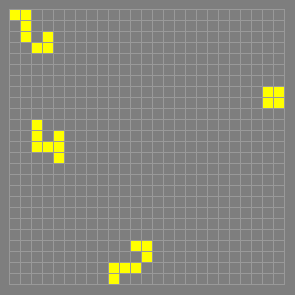One of the most common stable edge shooters. This
Herschel-to-glider converter suppresses the junk ordinarily left
behind by an evolving Herschel while allowing both the
first natural glider and second natural glider to escape on
transparent lanes:

The edge shooter output at the top has no additional clearance, so
its use in creating convoys is limited: it can only add gliders on
the outermost lanes of an existing glider salvo. Like the beehive
version of SW-2, either output can be used to build logical OR
gates, where multiple input signal paths are merged onto the same
output path.
The complete name for this converter is "NW31T120", where 31 is the
output glider lane number. In the above orientation, lane numbers
get bigger toward the upper right and smaller toward the lower left
(and may easily be negative).
The T120 timing measurement means that a canonical NW glider placed
on lane 31 at time T=120, at (+31, +0) relative to the input
Herschel, would in theory reach the exact same spacetime locations as
the converter's output glider does.
Most converters are not edge shooters and their output lanes are
not transparent, so they usually have catalysts that would interfere
with this theoretically equivalent glider. This is the case for the
optional third glider output created by the lower eater1 catalyst:
the upper eater1 overlaps its lane. For the alternate block
catalyst suppressing this glider output, see transparent lane.









